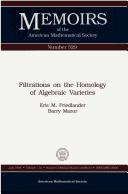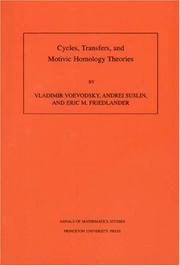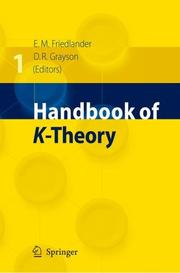| Listing 1 - 10 of 14 | << page >> |
Sort by
|
Book
ISBN: 3540106987 0387106987 3540386467 Year: 1981 Publisher: Berlin
Abstract | Keywords | Export | Availability | Bookmark
 Loading...
Loading...Choose an application
- Reference Manager
- EndNote
- RefWorks (Direct export to RefWorks)
Number theory --- 512 <061.3> --- Algebra--?<061.3> --- Algebraic number theory --- Geometry, Algebraic --- K-theory --- Congresses. --- 512 <061.3> Algebra--?<061.3> --- K-théorie --- Congresses --- Congrès et conférences. --- K-théorie. --- K-théorie.
Book
ISBN: 069108288X 1400881498 Year: 1982 Publisher: Princeton (N.J.): Princeton university press
Abstract | Keywords | Export | Availability | Bookmark
 Loading...
Loading...Choose an application
- Reference Manager
- EndNote
- RefWorks (Direct export to RefWorks)
This book presents a coherent account of the current status of etale homotopy theory, a topological theory introduced into abstract algebraic geometry by M. Artin and B. Mazur. Eric M. Friedlander presents many of his own applications of this theory to algebraic topology, finite Chevalley groups, and algebraic geometry. Of particular interest are the discussions concerning the Adams Conjecture, K-theories of finite fields, and Poincare duality. Because these applications have required repeated modifications of the original formulation of etale homotopy theory, the author provides a new treatment of the foundations which is more general and more precise than previous versions.One purpose of this book is to offer the basic techniques and results of etale homotopy theory to topologists and algebraic geometers who may then apply the theory in their own work. With a view to such future applications, the author has introduced a number of new constructions (function complexes, relative homology and cohomology, generalized cohomology) which have immediately proved applicable to algebraic K-theory.
Algebraic topology --- 512.73 --- 515.14 --- Homology theory --- Homotopy theory --- Schemes (Algebraic geometry) --- Geometry, Algebraic --- Deformations, Continuous --- Topology --- Cohomology theory --- Contrahomology theory --- Cohomology theory of algebraic varieties and schemes --- 515.14 Algebraic topology --- 512.73 Cohomology theory of algebraic varieties and schemes --- Homotopy theory. --- Homology theory. --- Abelian group. --- Adams operation. --- Adjoint functors. --- Alexander Grothendieck. --- Algebraic K-theory. --- Algebraic closure. --- Algebraic geometry. --- Algebraic group. --- Algebraic number theory. --- Algebraic structure. --- Algebraic topology (object). --- Algebraic topology. --- Algebraic variety. --- Algebraically closed field. --- Automorphism. --- Base change. --- Cap product. --- Cartesian product. --- Closed immersion. --- Codimension. --- Coefficient. --- Cohomology. --- Comparison theorem. --- Complex number. --- Complex vector bundle. --- Connected component (graph theory). --- Connected space. --- Coprime integers. --- Corollary. --- Covering space. --- Derived functor. --- Dimension (vector space). --- Disjoint union. --- Embedding. --- Existence theorem. --- Ext functor. --- Exterior algebra. --- Fiber bundle. --- Fibration. --- Finite field. --- Finite group. --- Free group. --- Functor. --- Fundamental group. --- Galois cohomology. --- Galois extension. --- Geometry. --- Grothendieck topology. --- Homogeneous space. --- Homological algebra. --- Homology (mathematics). --- Homomorphism. --- Homotopy category. --- Homotopy group. --- Homotopy. --- Integral domain. --- Intersection (set theory). --- Inverse limit. --- Inverse system. --- K-theory. --- Leray spectral sequence. --- Lie group. --- Local ring. --- Mapping cylinder. --- Natural number. --- Natural transformation. --- Neighbourhood (mathematics). --- Newton polynomial. --- Noetherian ring. --- Open set. --- Opposite category. --- Pointed set. --- Presheaf (category theory). --- Reductive group. --- Regular local ring. --- Relative homology. --- Residue field. --- Riemann surface. --- Root of unity. --- Serre spectral sequence. --- Shape theory (mathematics). --- Sheaf (mathematics). --- Sheaf cohomology. --- Sheaf of spectra. --- Simplex. --- Simplicial set. --- Special case. --- Spectral sequence. --- Surjective function. --- Theorem. --- Topological K-theory. --- Topological space. --- Topology. --- Tubular neighborhood. --- Vector bundle. --- Weak equivalence (homotopy theory). --- Weil conjectures. --- Weyl group. --- Witt vector. --- Zariski topology. --- Homologie --- Topologie algebrique --- Geometrie algebrique --- Homotopie
Book
Year: 1982 Publisher: Princeton Princeton University Press, University of Tokyo Press
Abstract | Keywords | Export | Availability | Bookmark
 Loading...
Loading...Choose an application
- Reference Manager
- EndNote
- RefWorks (Direct export to RefWorks)
Book
ISBN: 9781400881499 Year: 2016 Publisher: Princeton, NJ
Abstract | Keywords | Export | Availability | Bookmark
 Loading...
Loading...Choose an application
- Reference Manager
- EndNote
- RefWorks (Direct export to RefWorks)

ISSN: 00659266 ISBN: 0821825917 Year: 1994 Publisher: Providence, R.I. American Mathematical Society
Abstract | Keywords | Export | Availability | Bookmark
 Loading...
Loading...Choose an application
- Reference Manager
- EndNote
- RefWorks (Direct export to RefWorks)
Algebraic topology --- Algebraic cycles --- Filters (Mathematics) --- Homology theory --- Homologie --- Filtres (mathématiques) --- Cycles algébriques --- Cohomology theory --- Contrahomology theory --- Mathematics --- Cycles, Algebraic --- Geometry, Algebraic --- Homologie. --- Cycles algébriques.

ISBN: 0691048142 0691048150 9786613379825 1283379821 140083712X 9780691048147 9780691048154 Year: 2011 Volume: 143 Publisher: Princeton, NJ : Princeton University Press,
Abstract | Keywords | Export | Availability | Bookmark
 Loading...
Loading...Choose an application
- Reference Manager
- EndNote
- RefWorks (Direct export to RefWorks)
The original goal that ultimately led to this volume was the construction of "motivic cohomology theory," whose existence was conjectured by A. Beilinson and S. Lichtenbaum. This is achieved in the book's fourth paper, using results of the other papers whose additional role is to contribute to our understanding of various properties of algebraic cycles. The material presented provides the foundations for the recent proof of the celebrated "Milnor Conjecture" by Vladimir Voevodsky. The theory of sheaves of relative cycles is developed in the first paper of this volume. The theory of presheaves with transfers and more specifically homotopy invariant presheaves with transfers is the main theme of the second paper. The Friedlander-Lawson moving lemma for families of algebraic cycles appears in the third paper in which a bivariant theory called bivariant cycle cohomology is constructed. The fifth and last paper in the volume gives a proof of the fact that bivariant cycle cohomology groups are canonically isomorphic (in appropriate cases) to Bloch's higher Chow groups, thereby providing a link between the authors' theory and Bloch's original approach to motivic (co-)homology.
Bundeltheorie --- Cohomology [Sheaf ] --- Faisceaux [Théorie des ] --- Sheaf cohomology --- Sheaf theory --- Sheaves (Algebraic topology) --- Sheaves [Theory of ] --- Théorie des faisceaux --- Algebraic cycles --- Homology theory --- Algebraic cycles. --- Homology theory. --- Cohomology theory --- Contrahomology theory --- Algebraic topology --- Cycles, Algebraic --- Geometry, Algebraic --- Abelian category. --- Abelian group. --- Addition. --- Additive category. --- Adjoint functors. --- Affine space. --- Affine variety. --- Alexander Grothendieck. --- Algebraic K-theory. --- Algebraic cycle. --- Algebraically closed field. --- Andrei Suslin. --- Associative property. --- Base change. --- Category of abelian groups. --- Chain complex. --- Chow group. --- Closed immersion. --- Codimension. --- Coefficient. --- Cohomology. --- Cokernel. --- Commutative property. --- Commutative ring. --- Compactification (mathematics). --- Comparison theorem. --- Computation. --- Connected component (graph theory). --- Connected space. --- Corollary. --- Diagram (category theory). --- Dimension. --- Discrete valuation ring. --- Disjoint union. --- Divisor. --- Embedding. --- Endomorphism. --- Epimorphism. --- Exact sequence. --- Existential quantification. --- Field of fractions. --- Functor. --- Generic point. --- Geometry. --- Grothendieck topology. --- Homeomorphism. --- Homogeneous coordinates. --- Homology (mathematics). --- Homomorphism. --- Homotopy category. --- Homotopy. --- Injective sheaf. --- Irreducible component. --- K-theory. --- Mathematical induction. --- Mayer–Vietoris sequence. --- Milnor K-theory. --- Monoid. --- Monoidal category. --- Monomorphism. --- Morphism of schemes. --- Morphism. --- Motivic cohomology. --- Natural transformation. --- Nisnevich topology. --- Noetherian. --- Open set. --- Pairing. --- Perfect field. --- Permutation. --- Picard group. --- Presheaf (category theory). --- Projective space. --- Projective variety. --- Proper morphism. --- Quasi-projective variety. --- Residue field. --- Resolution of singularities. --- Scientific notation. --- Sheaf (mathematics). --- Simplicial complex. --- Simplicial set. --- Singular homology. --- Smooth scheme. --- Spectral sequence. --- Subcategory. --- Subgroup. --- Summation. --- Support (mathematics). --- Tensor product. --- Theorem. --- Topology. --- Triangulated category. --- Type theory. --- Universal coefficient theorem. --- Variable (mathematics). --- Vector bundle. --- Vladimir Voevodsky. --- Zariski topology. --- Zariski's main theorem. --- 512.73 --- 512.73 Cohomology theory of algebraic varieties and schemes --- Cohomology theory of algebraic varieties and schemes

ISBN: 354023019X 3540336257 3540304363 3540278559 9783540230199 Year: 2005 Publisher: Berlin Springer
Abstract | Keywords | Export | Availability | Bookmark
 Loading...
Loading...Choose an application
- Reference Manager
- EndNote
- RefWorks (Direct export to RefWorks)
This handbook offers a compilation of techniques and results in K-theory. These two volumes consist of chapters, each of which is dedicated to a specific topic and is written by a leading expert. Many chapters present historical background; some present previously unpublished results, whereas some present the first expository account of a topic; many discuss future directions as well as open problems. The overall intent of this handbook is to offer the interested reader an exposition of our current state of knowledge as well as an implicit blueprint for future research. This handbook should be especially useful for students wishing to obtain an overview of K-theory and for mathematicians interested in pursuing challenges in this rapidly expanding field.
K-theory. --- K-theory --- 512.7 --- Algebraic topology --- Homology theory --- 512.7 Algebraic geometry. Commutative rings and algebras --- Algebraic geometry. Commutative rings and algebras --- Geometry, algebraic. --- Algebraic topology. --- Number theory. --- K-Theory. --- Algebraic Geometry. --- Algebraic Topology. --- Number Theory. --- Number study --- Numbers, Theory of --- Algebra --- Topology --- Algebraic geometry --- Geometry --- Algebraic geometry. --- Number theory

ISBN: 9782856291597 2856291597 Year: 2003 Publisher: Paris: Société mathématique de France,
Abstract | Keywords | Export | Availability | Bookmark
 Loading...
Loading...Choose an application
- Reference Manager
- EndNote
- RefWorks (Direct export to RefWorks)
Algebra, Homological. --- Functor theory. --- Representations of groups. --- Vector spaces. --- Finite fields (Algebra) --- Steenrod algebra.
Digital
Abstract | Keywords | Export | Availability | Bookmark
 Loading...
Loading...Choose an application
- Reference Manager
- EndNote
- RefWorks (Direct export to RefWorks)
Number theory --- Geometry --- Physics --- landmeetkunde --- topologie (wiskunde) --- wiskunde --- fysica --- getallenleer
Book
ISBN: 9783540278559
Abstract | Keywords | Export | Availability | Bookmark
 Loading...
Loading...Choose an application
- Reference Manager
- EndNote
- RefWorks (Direct export to RefWorks)
This handbook offers a compilation of techniques and results in K-theory. These two volumes consist of chapters, each of which is dedicated to a specific topic and is written by a leading expert. Many chapters present historical background; some present previously unpublished results, whereas some present the first expository account of a topic; many discuss future directions as well as open problems. The overall intent of this handbook is to offer the interested reader an exposition of our current state of knowledge as well as an implicit blueprint for future research. This handbook should be especially useful for students wishing to obtain an overview of K-theory and for mathematicians interested in pursuing challenges in this rapidly expanding field.
Number theory --- Geometry --- Physics --- landmeetkunde --- topologie (wiskunde) --- wiskunde --- fysica --- getallenleer
| Listing 1 - 10 of 14 | << page >> |
Sort by
|

 Search
Search Feedback
Feedback About UniCat
About UniCat  Help
Help News
News